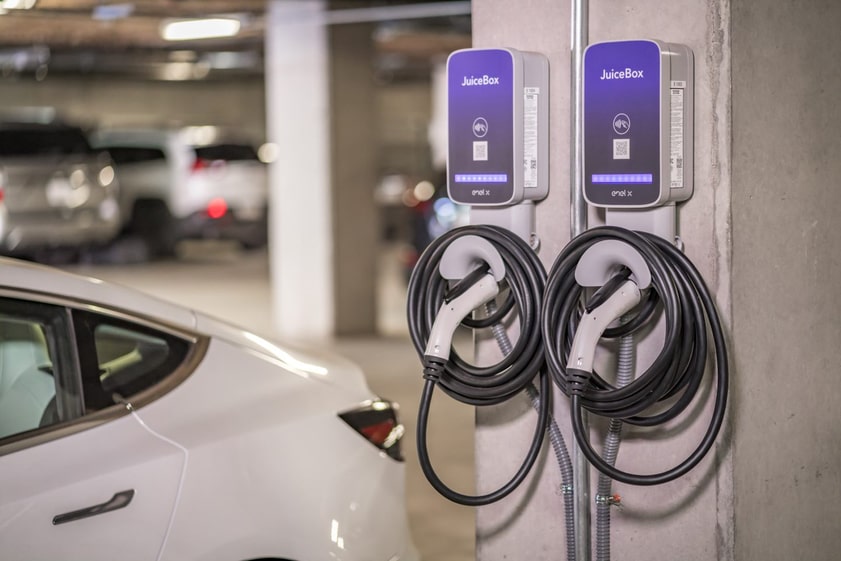How the Rise of EV Charging Will Impact Multifamily Communities

The last few years have seen an exponential rise in the use of electric vehicles (EVs). Consumers choose EVs to reduce their carbon footprint and cut down on fuel costs. According to JD Power, almost 80% of electric vehicle users charge their EV overnight at their residence. Homeowners aren'/ca/en/t the only ones participating in this trend, as nearly 50% of multifamily projects have electric vehicle supply equipment (EVSE).
This could be in part due to a rise in the number of Right to Charge laws, which require developers to provide EV charging stations for multifamily dwellings. Besides this, EV-Ready codes require that a certain percentage of the parking area in multifamily communities be ready for EV charging when the demand arises.
This means setting up an electric circuit with sufficient capacity for charging EVs. But it'/ca/en/s not just about regulatory requirements. There are several benefits for building owners to install EV charging stations at their property.
This article will explore those benefits and the impact that installing EV charging stations has on multifamily communities.
4 Ways EV Charging Affects Multifamily Communities
As stated before, several positive outcomes have resulted from the increase in EV charging stations for multifamily communities.
Increased EV Adoption
Investing in EV charging infrastructure is an excellent way for multifamily communities to attract environmentally- conscious tenants who want to live green. Providing electric vehicle charging stations helps property owners create a greener living option, positioning them as an eco-friendly community with a good social reputation.
Decreased Dependency on Gasoline
EV charging stations can significantly reduce an EV driver’s fuel costs by up to $200 per month.
One study showed that EV owners who charge at home could expect to save, on average, $800 to $1,000 a year on fuel costs over an equivalent gasoline-powered vehicle.
Limited Strain on the Local Power Grid
Smart EV chargers can ease the strain on electricity grids during peak times. EV chargers generally consume less energy than a water heater or dryer and should not impact other utilities being used simultaneously.
The Benefits of EV Charging for Property Owners
Additionally, there are many benefits to the building owners who invest in EV charging equipment.
Tax Rebates
There are numerous federal and state-level Electric Vehicle Supply Equipment (EVSE) rebates and tax credits that multifamily property owners can utilize to install dedicated EV chargers. For example, tax rebates can go as high as $80,000 for property owners who purchase and install charging units in California. In Arizona, rebates can go up to $24,000 for installing each EVSE port.
Raised Property Value
EV chargers also increase property value and allow property owners to command higher rents for EV-friendly units. EV charging stations provide a unique selling point that differentiates your property from others, giving a multifamily property owner a competitive advantage in pricing.
Attract More Desirable Tenants
It also makes the property more attractive to environmentally- conscious tenants living in a sustainability-minded community. These tenants will often be willing to pay higher rent to live in a green community.
Types of EV Charging Stations Available for Multifamily Communities
Now that you know the impact of EV charging stations on multifamily properties and the benefits for property owners, let'/ca/en/s briefly touch on the charging stations that property owners can employ. EV charging stations come in three levels depending on the power capacity available at the property.
• Level 1: This charges at 3 to 5 miles per hour using a regular 120-volt outlet. This is the standard outlet available in most households.
• Level 2: This charges at 12 to 80 miles per hour using a 208 to a 240-volt charging outlet.
• Level 3: This charges at 3 to 20 miles per minute using direct current. This is unlike Level 1 and Level 2 chargers which rely on alternating current.
Multifamily properties typically use Level 2 or Level 3 stations. Let'/ca/en/s look at an example of an Enel X customer who leveraged EV charging stations at their multifamily property.
How Sage Condominiums Benefited from EV Charging Stations
The Sage Condominium community includes 122 luxury waterfront townhomes and condos. Each unit has modern amenities like programmable thermostats and a chef'/ca/en/s kitchen with high-end stainless-steel appliances.
When the SRP EVSE incentive opportunities became available, Sage'/ca/en/s property owners decided to jump on it. They took advantage of the SRP Commercial EV Charger rebate and paid only 8% of the total cost to install EV charging equipment.
The Sage HOA faced the challenge of a limited electricity supply for charging stations in the parking garage. However, the Enel X JuiceBox Pro Smart EV charging stations met their requirements and empowered them to qualify for commercial incentives.
You can learn more about their story here.
Conclusion
The bottom line is that the demand for EVs will continue to rise. As technology becomes more accessible, consumers have a strong incentive to make the shift that will naturally impact the residential units they live in. Property owners stand to benefit substantially by participating in this emerging trend.
Along with increased property values and significant tax incentives, installing EV chargers promotes sustainability and can attract environmentally- conscious tenants. Considering these benefits, investing in EV chargers today for your multifamily properties will continue to yield results in the future.
To learn more about how Enel X can support your multifamily properties with EV charging stations, reach out to us today.


